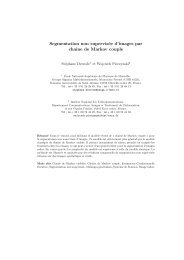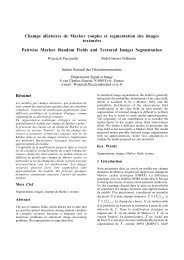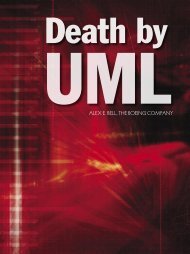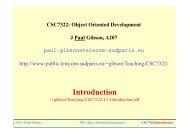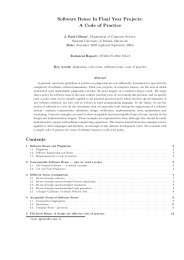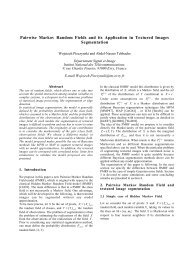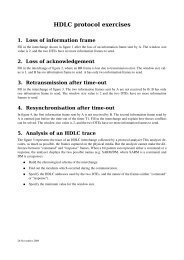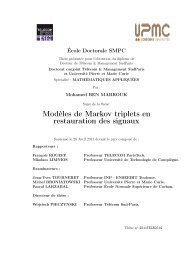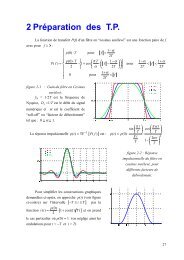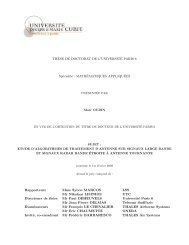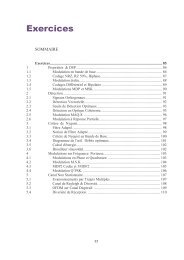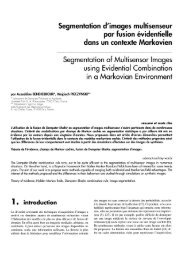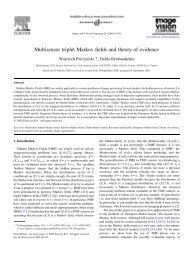Estimation Of Generalized Mixtures And Its Application ... - IEEE Xplore
Estimation Of Generalized Mixtures And Its Application ... - IEEE Xplore
Estimation Of Generalized Mixtures And Its Application ... - IEEE Xplore
Create successful ePaper yourself
Turn your PDF publications into a flip-book with our unique Google optimized e-Paper software.
1374 <strong>IEEE</strong> TRANSACTIONS ON IMAGE PROCESSING, VOL. 6, NO. 10, OCTOBER 19973) estimate priors;4) estimate the “true” class image.Assuming that each of unknown noise probability distributionis in the Pearson system, our methods are based onmerging two approaches of classical problems. On the onehand, we use classical mixture estimation methods like EM[5], [9], [31], SEM [24], [26], or ICE [3], [4], [26]–[28].On the other hand, we use the fact that if we know that thesample considered proceeds from one family in the Pearsonsystem, we dispose of decision rule, based on “skewness” and“kurtosis,” for which family it belongs to. Different algorithmsproposed are then applied to the problem of unsupervisedBayesian image segmentation in a “local” and “global” way.The results of numerical studies of a synthetic image andsome real ones, and other results presented in [22], show theinterest of the generalized mixture estimation in the unsupervisedimage segmentation context. In particular, the mixturecomponents are, in general, correctly estimated.As possibilities for future work, let us mention the possibilityof testing the methods proposed in many problems outsidethe image segmentation context, like handwriting recognition,speech recognition, or any other statistical problem requiringa mixture recognition. Furthermore, it would undoubtedlybe of purpose studying other generalized mixture estimationapproaches, based on different decision rules and allowing oneto leave the Pearson system.ACKNOWLEDGMENTThe image of Fig. 3 was provided by CIRAD SA underthe project GDR ISIS. The authors thank A. Bégué for hercollaboration.REFERENCES[1] R. Azencott, Ed., Simulated Annealing: Parallelization Techniques.New York: Wiley, 1992.[2] J. Besag, “On the statistical analysis of dirty pictures,” J. R. Stat. Soc.B, vol. 48, pp. 259–302, 1986.[3] B. Braathen, W. Pieczynski, and P. Masson, “Global and local methodsof unsuperivsed Bayesian segmentation of images,” Machine Graph.Vis., vol. 2, pp. 39–52, 1993.[4] H. Caillol, W. Pieczynski, and A. Hillon, “<strong>Estimation</strong> of fuzzy Gaussianmixture and unsupervised statistical image segmentation,” <strong>IEEE</strong> Trans.Image Processing, vol. 6, pp. 425–440, 1997.[5] B. Chalmond, “An iterative Gibbsian technique for reconstruction ofm-ary images,” Pattern Recognit., vol. 22, pp. 747–761, 1989.[6] R. Chellapa and R. L. Kashyap, “Digital image restoration using spatialinteraction model,” <strong>IEEE</strong> Trans. Acoust., Speech, Signal Processing, vol.ASSP-30, pp. 461–472, 1982.[7] R. Chellapa and A. Jain, Eds., Markov Random Fields. New York:Academic,1993.[8] Y. Delignon, “Etude statistique d’images radar de la surface de la mer,”Ph.D. dissertation, Université de Rennes I, Rennes, France, 1993.[9] A. P. Dempster, N. M. Laird, and D. B. Rubin, “Maximum likelihoodfrom incomplete data via the EM algorithm,” J. R. Stat. Soc. B, vol. 39,pp. 1–38, 1977.[10] H. Derin and H. Elliot, “Modeling and segmentation of noisy andtextured images using Gibbs random fields,” <strong>IEEE</strong> Trans. Pattern Anal.Machine Intell., vol. 9, pp. 39–55, 1987.[11] P. A. Devijver, “Hidden Markov mesh random field models in imageanalysis,” in Advances in Applied Statistics, Statistics and Images: 1.Abingdon, U.K.: Carfax, 1993, pp. 187–227.[12] R. C. Dubes and A. K. Jain, “Random field models in image analysis,”J. Appl. Stat., vol. 16, 1989.[13] S. Geman and G. Geman, “Stochastic relaxation, Gibbs distributions andthe Bayesian restoration of images,” <strong>IEEE</strong> Trans. Pattern Anal. MachineIntell, vol. PAMI-6, pp. 721–741, 1984.[14] N. Giordana and W. Pieczynski, “<strong>Estimation</strong> of generalized multisensorhidden Markov chains and unsupervised image segmentation,” <strong>IEEE</strong>Trans. Pattern Anal. Machine Intell., vol. 19, pp. 465–475, 1997.[15] X. Guyon, “Champs aléatoires sur un réseau,” in Collection TechniquesStochastiques. Paris, France: Masson, 1993.[16] R. Haralick and J. Hyonam, “A context classifier,” <strong>IEEE</strong> Trans. Geosci.Remote Sensing, vol. GE-24, pp. 997–1007, 1986.[17] N. L. Johnson and S. Kotz, Distributions in Statistics: ContinuousUnivariate Distributions, vol. 1. New York: Wiley, 1970.[18] R. L. Kashyap and R. Chellapa, “<strong>Estimation</strong> and choice of neighborsin spatial-interaction models of images,” <strong>IEEE</strong> Trans. Inform. Theory,vol. 29, pp. 60–72, 1983.[19] P. A. Kelly, H. Derin, and K. D. Hartt, “Adaptive segmentation ofspeckled images using a hierarchical random field model,” <strong>IEEE</strong> Trans.Acoust., Speech, and Signal Processing, vol. 36, pp. 1628–1641, 1988.[20] S. Lakshmanan and H. Herin, “Simultaneous parameter estimationand segmentation of Gibbs random fields,” <strong>IEEE</strong> Trans. Pattern Anal.Machine Intell., vol. 11, pp. 799–813, 1989.[21] J. Marroquin, S. Mitter, and T. Poggio, “Probabilistic solution of illposedproblems in computational vision,” J. Amer. Stat. Assoc., vol. 82,pp. 76–89, 1987.[22] A. Marzouki, “Segmentation statistique d’images radar,” Ph.D. dissertation,Université de Lille I, Lille, France, Nov. 1996.[23] A. Marzouki, Y. Delignon, and W. Pieczynski, “Adaptive segmentationof SAR images,” in Proc. OCEAN ’94, Brest, France.[24] P. Masson and W. Pieczynski, “SEM algorithm and unsupervisedsegmentation of satellite images, <strong>IEEE</strong> Trans. Geosci. Remote Sensing,vol. 31, pp. 618–633, 1993.[25] E. Mohn, N. Hjort, and G. Storvic, “A simulation study of somecontextual clasification methods for remotely sensed data,” <strong>IEEE</strong> Trans.Geosci. Remote Sensing, vol. GE-25, pp. 796–804, 1987.[26] A. Peng and W. Pieczynski, “Adaptive mixture estimation and unsupervisedlocal Bayesian image segmentation,” Graph. Models ImageProcessing, vol. 57, pp. 389–399, 1995.[27] W. Pieczynski, “Mixture of distributions, Markov random fields andunsupervised Bayesian segmentation of images,” Tech. Rep. no. 122,L.S.T.A., Université Paris VI, Paris, France, 1990.[28] , “Statistical image segmentation,” Machine Graph. Vis., vol. 1,pp. 261–268, 1992.[29] W. Qian and D. M. Titterington, “On the use of Gibbs Markov chainmodels in the analysis of images based on second-order pairwiseinteractive distributions,” J. Appl. Stat., vol. 16, pp. 267–282, 1989.[30] H. C. Quelle, J.-M. Boucher, and W. Pieczynski, “Adaptive parameterestimation and unsupervised image segmentation,” Machine Graph. Vis.,vol. 5, pp. 613–631, 1996.[31] R. A. Redner and H. F. Walker, “Mixture densities, maximum likelihoodand the EM algorithm,” SIAM Rev., vol. 26, pp. 195–239, 1984.[32] A. Rosenfeld, Ed., Image Modeling. New York: Academic, 1981.[33] J. Tilton, S. Vardeman, and P. Swain, “<strong>Estimation</strong> of context for statisticalclassification of multispectral image data,” <strong>IEEE</strong> Trans. Geosci.Remote Sensing, vol. GE-20, pp. 445–452, 1982.[34] A. Veijanene, “A simulation-based estimator for hidden Markov randomfields,” <strong>IEEE</strong> Trans. Pattern Anal. Machine Intell., vol. 13, pp. 825–830,1991.[35] L. Younes, “Parametric inference for imperfectly observed Gibbsianfields,” Prob. Theory Related Fields, vol. 82, pp. 625–645, 1989.[36] J. Zerubia and R. Chellapa, “Mean field annealing using compoundGauss-Markov random fields for edge detection and image estimation,”<strong>IEEE</strong> Trans. Neural Networks, vol. 8, pp. 703–709, 1993.[37] J. Zhang, “The mean field theory in EM procedures for blind Markovrandom field image restoration,” <strong>IEEE</strong> Trans. Image Processing, vol. 2,pp. 27–40, 1993.[38] J. Zhang, J. W. Modestino, and D. A. Langan, “Maximum likelihoodparameter estimation for unsupervised stochastic model-based imagesegmentation,” <strong>IEEE</strong> Trans. Image Processing, vol. 3, pp. 404–420,1994.Yves Delignon received the Ph.D. degree in signalprocessing from the Université de Rennes 1, Rennes,France, in 1993.He is currently Associate Professor at the EcoleNouvelle d’Ingénieurs en Communication, Lille,France. His research interests include statisticalmodeling, unsupervised segmentation and patternrecognition in case of multisource data.



